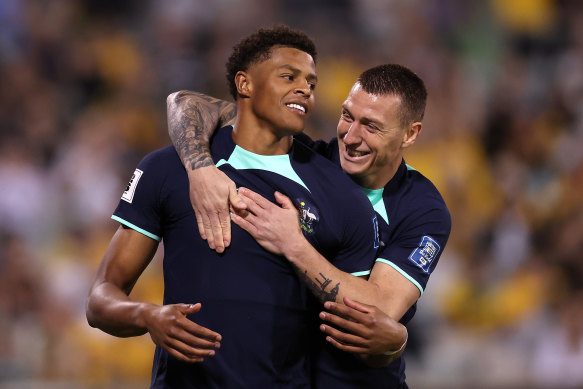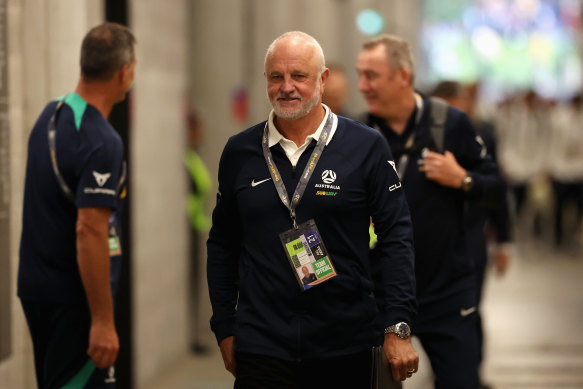This was published 10 months ago
Why two ‘dead rubbers’ in June could shape Socceroos’ 2026 World Cup hopes
By Vince Rugari
Graham Arnold will aim to balance the freedom to experiment that the Socceroos have earned in the current stage of World Cup qualifying with the need to bank as many FIFA ranking points as possible to ensure a smoother path and a potentially easy group at the expanded 2026 tournament.
Tuesday night’s comfortable 5-0 win over Lebanon confirmed Australia’s spot in the next stage of qualifiers with two matches – away to Bangladesh and home to Palestine – left to spare.
But they are not necessarily dead rubbers.
According to the live FIFA rankings, which will not be officially updated by the world governing body until next month, the Socceroos (No.24) are locked in a tight battle with South Korea (No.23) in the race for a coveted top-three position in Asia, behind Japan (No.18) and Iran (No.20).
The top three is important because the 18 teams who reach the AFC’s third round of qualification – which begins in September – are expected to be split into six pots of three, from which three groups of six will be drawn, with the top two in each to clinch direct qualification for the 2026 World Cup in the United States, Canada and Mexico.
A spot in pot one would ensure the Socceroos avoid any match-ups with Japan or Iran and thus a simpler task in qualifying – albeit with the caveat that, as Arnold keeps saying, teams across the rest of Asia continue to improve rapidly.

Kusini Yengi and Mitchell Duke embrace after the former’s goal against Lebanon.Credit: Getty
If Australia was to leapfrog South Korea in the June window and land in pot one, the toughest possible group they could face – using the live rankings and current positions in the current qualification round as a rough guide – would include Korea, Iraq, Jordan, China and Kyrgyzstan.
Even if the Socceroos finished third in such a group, they would still be able to qualify directly for the World Cup in the AFC’s fourth round, where two more direct slots will be on offer, or the fifth round, where the winner will face the intercontinental play-offs against a team from North and Central America, South America or Oceania – the same route Australia were forced down to reach Russia 2018 and Qatar 2022.
Asia’s allocation of World Cup slots has increased from 4.5 to 8.5 due to the tournament’s controversial expansion from 32 to 48 teams, with the 2026 edition to be the first of that size. While the AFC has not publicly released the draw mechanics for the third round, the Socceroos are working on the presumption it will operate as explained. Ranking points will also ultimately determine the World Cup draw, and whether the Socceroos – if they make it – find themselves in another ‘group of death’ or in a more hospitable pool.
Arnold acknowledged he had scope to try out new faces or systems against Bangladesh and Palestine, and that some of his senior players may need a proper post-season holiday to refresh themselves physically and mentally, but said his priority was winning both games and securing the maximum number of ranking points.

Graham Arnold is juggling multiple priorities during World Cup qualification.Credit: Getty
“I’m not into giving caps away. To earn a cap, it needs to be deserved,” he said.
“But some of the older boys, maybe they need a break – especially after they come off the back of the World Cup and then go back their clubs, and then they’ve had an Asian Cup in the middle of the season. It’s something further down the track, I’ll be contacting all the boys and having a good chat to them on how they feel and if they need a break.”
Arnold has thus far successfully juggled the dual priorities of winning games and blooding new players as he continues to turn over Australia’s squad. Three players – John Iredale, Patrick Yazbek and Josh Nisbet – made their debuts in this window, while four players – Iredale, Kusini Yengi, Kye Rowles and Keanu Baccus – scored their maiden international goals.
Only 10 players from the Socceroos’ match day squad in Canberra were in Arnold’s squad for the 2022 World Cup.
“If you don’t give kids a chance, you never know,” Arnold said.
“Giving them the opportunity here [in Canberra] and to be able to play in front of a full crowd will inspire them to when they go back to their clubs to improve more and want more, and that’s important for us in the future.”
But as players dispersed on Wednesday to their clubs around the world, they left with a stern message from Arnold ringing in their ears.
“I had a strong conversation with the players about individual quality and ownership, because I get one session, two sessions [with them],” he said.
“Basically, you’ve got to be the finished product when you come into camp. If you’re doing shooting, for example – do more at your club and remember what I’m saying to you, put the ball in the back of the net when you’re shooting. It’s not there for fun, it’s a job.
“All those technical skills and that, I don’t get time to train them. They’ve got to be the finished product physically, technically. Tactically, we give them a structure, but for me, our strength is the Aussie DNA, the mentality and that’s what we’re working hard on.”
Sports news, results and expert commentary. Sign up for our Sport newsletter.